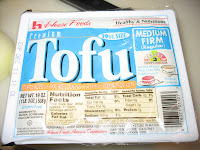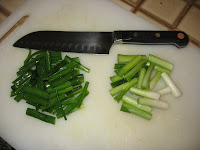WARNING:
Due to the near-&-dear nature of the dish at hand,
speaker waxes ad nauseum of theory, conjecture, and anecdotes.
If not interested in such privations please skip to Ingredients and Direction section.
It’s one of those things. Somewhere deep down in your soul, from the primordial matrix of things and thought that makes one Korean, wells up emotions that can only be described as home and love with only but a waft of the idea. It’s that nostalgia-evoking, tear-jerking, mouth-watering, tongue-scorching concoction of Korean soul food goodness.
My experience with kimchi chigeh has been varied, to say the least. There is the benchmark which was fearfully prepared from kimchi fermented in clay pots buried underground through a snowy winter, by a diminutive grayed grandmother from a mythical village in the mist covered mountains of North Korea. And then, there is the tragedy I use to throw together in college, inspired only by my immature bravado, using raw kimchi, Tabasco sauce, hotdogs, and spoonfuls of imitation butter. One was pungent and savory, spicy and sweet, robust and full-bodied, with flavors only a maestro could convict out from the orchestra of perfect ingredients. The other could barely be considered sustenance (my deepest apologies to my college roommates who suffered through my learning curve). Then, there are the countless forgettable, less-than-satisfying kimchi chigeh experiences at the local eateries here and there [excursis: I’m not disparaging restaurants, but you just can’t make good chigeh in 15 minutes. It’s my bad for expecting good chigeh in the same time you get bulgogi, ya know?]
Over the years, after agonizing through dozens of trials and mistakes, and even a few recent successes, I’ve developed a working theory. It goes like this: “It tastes good because it’s not missing anything. If it tastes bad, it’s missing something.” Now, this does not mean to throw everything you got in it. It does mean that there are components that I believe has to be there, that span the depth of the flavor spectrum. I believe there are 4:
- Bright Herbaciousness on the Surface
- green onions
- goh-chu-gha-ru (Korean chili powder)
- Sweet & Sour Sub-Surface Thrust
- sour from the well fermented kimchi
- sweetness of well fermented kimchi,
- sweat onions
- Earthy/Meaty Foundation
- cabbage & radish components of kimchi
- beef &/or pork
- Deep Under-Current of Oceany Brininess (Umami, if you will)
- squid, anchovy, or oyster components of kimchi
- dried anchovies (or fish sauce)
- M.F.G – mysterious fermentational goodness
Ingredients:
- 2lbs Kimchi, well fermented
- 1 cup Kimchi Brine
- 2 cups Beef Broth (can substitute with ½ lbs of stew beef if you want a more meaty chigeh)
- Water (to cover ingredients in Stage 1)
- ¾ lb Pork Belly slab, skin attached
- 1 lb Tofu (medium to firm, 2” cubes)
- 3-5 large Dried Anchovies (substitute w/1tbsn of fish sauce)
- 1 large SWEET Onion
- 3-4 stalks Green Onions
- Goh-Chu-Gah-Ru (Korean red chili powder) to taste in regards to spice.

Directions:
Stage 1
- Obtain well fermented kimchi; should smell ferocious, but still edible (see Helpful Hint); if whole or quartered kimchi, cut into bite size portions.
- Break down Sweet Onions into bite-size cuts
- Dice and drain tofu into large cubes, according to your preference.
- Dice green onions into 1-2” strips,
- Slice pork belly through layers into ½” thick squares
- Remove head and guts from dried Anchovies.
Stage 2
- Into a large stockpot add all ingredients, except for Tofu, Pork Belly, and half of the Green onions, including all the white parts of the green onions.
- Bring to a boil and reduce to simmer for about 1.5 (yes, that long; open some windows)
- Taste for salt, and also for sweetness; add salt and sugar to taste; start with small amounts (do not add sugar in the beginning; sugar will over-soften kimchi and make it mushy.) You may also need to add water, depending on saltiness
- Add Pork Belly and Tofu and bring to boil and reduce to simmer for 30 more min (don’t overcook pork belly; it will fall apart and that’s no fun).
Stage 3
- Add remaining green onions and goh-chu-gah-ru to taste, and let simmer for 5 min.
- Remove from heat and let cool slightly before serving.
- Serve in separate bowls or just go nuts and double-dip old-school Korean family style.
Helpful Tips:
- If purchasing kimchi, allow the bottle to ferment outside (not necessarily outdoors; your neighbors will hate you, even if they’re Korean) of the fridge for two days. Make sure to have a catch for the overflowing juices; yes, it will leak even through the lid. Your house will smell like death too.
- Plan ahead. Every time you have some kimchi, collect the left-overs, including the brine, in a sealed jar or tupperware, and stow it way back in the fridge. If you're like me, you should have enough product by the end of the month.
- Drain Tofu well. If you don't, you will get lots of excess liquid that will muttle and mute the bright flavors. Dice up the tofu early in Stage 1 and allow liquids to leach out.
Short Cuts:
There are no good short cuts. Please take my word on this. In my frequent desperations to satisfy my kimchi chigeh fix, I’ve done all kinds of things – add vinegar to raw kimchi, add butter, lots of sugar, sesame seed oil, blast with High heat, add Spam, (no, wait, Spam does work J ), etc… nothing (else) worked to achieve the matured flavors that can only come from good ingredients and low-slow cooking.
Final Words:
I do understand that, even to this day, debates rage as to what makes for the best kimchi chigeh. And I would only humbly add that my recipe is but one of many that may be considered enjoyable. Again, my tenants compose a theory, and not fact. It is definitely a work in progress. I do hope that one day, that one of my concoctions will at least touch the fringes of the hem of the masters. Speaking of masters, I would be remised if I do not offer my deepest love, respect and thanks to the grayed grandmother from the mythical village in the mist covered mountains of North Korea, for cooking tirelessly in the church kitchen to provide me with that magical bowl that will forever haunt my heart and dreams, and of course, to my mom who raised me on her wonderful beloved kimchi chigeh that can never be separated with my thoughts of home and her love.
I hope you enjoy it. Let us know.













